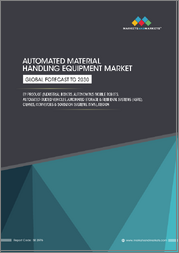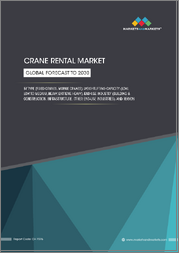
|
시장보고서
상품코드
1642856
크레인 시장 규모, 점유율, 동향, 예측 : 제품 유형, 용도, 지역별(2025-2033년)Crane Market Size, Share, Trends and Forecast by Product Type, Application, and Region, 2025-2033 |
||||||
크레인 세계 시장 규모는 2024년 536억 달러에 달했습니다. 향후 IMARC Group은 2033년에는 779억 달러에 이르고, 2025년부터 2033년에 걸쳐 3.82%의 성장률(CAGR)을 나타낼 것으로 예측했습니다. 북미의 크레인 시장 점유율은 미국이 71.0%를 차지하고 있습니다. 미국 시장은 건설, 에너지, 인프라 개발 분야의 강력한 확장에 의해 주도되고 있습니다.
크레인은 권상기, 와이어 로프, 체인 및 시브가 장착된 기계로, 재료의 승강 및 수평 이동에 사용됩니다. 고대의 기원을 가진 크레인은 수세기에 걸쳐 진화를 이루고 있으며 현재는 건설, 해운, 제조 등 다양한 산업에서 도움이 되고 있습니다. 크레인에는 다양한 유형과 크기가 있으며, 각각 특정 작업을 수행하도록 특별히 설계되었습니다. 타워 크레인은 초고층 빌딩 건설에서 흔히 볼 수 있으며 높이와 리프팅 능력의 조합을 제공하며 무거운 재료를 수직으로 이동시키는 효율적인 방법을 제공합니다. 이동식 크레인은 다재다능하고 쉽게 운반할 수 있으므로 빠르고 단기적인 프로젝트에 이상적입니다.
세계 시장을 견인하고 있는 것은 석유 및 가스 분야에 있어서의 탐사 작업에 최신의 크레인이 채용되고 있는 것이며, 이것도 시장 확대에 박차를 가하고 있는 중요한 요인입니다. 크레인 제조에 최첨단 기술을 도입하여 수력 발전 프로젝트에서 터널과 입갱 건설 중 토사와 파편 제거 등 특정 용도로 설계된 특수 크레인이 탄생했습니다. 이러한 특수화가 주목을 받고 시장의 역동성에 기여하고 있습니다. 또한 업계의 주요 기업은 실시간 성능 추적 기능을 갖춘 이동식 크레인 모델을 도입하여 귀중한 운영 통찰력을 제공합니다. 또한 급속한 산업 성장과 에너지 및 자동차를 포함한 부문에서 크레인 사용 증가가 시장 상승 궤도에 박차를 가하고 있습니다. 요컨대, 인프라 투자, 기술 혁신, 광범위한 산업용도의 조합이 세계 크레인 시장을 견인하고 있습니다. 지속가능성에 대한 주목이 높아지고 있는 가운데, 풍력발전소나 태양광발전소 등의 재생 가능 에너지 프로젝트에 상당액의 투자가 이루어지고 있습니다. 이 프로젝트는 풍력 터빈과 태양전지판과 같은 무겁고 섬세한 장비를 들어 올릴 수있는 특수 크레인이 필요하며 시장의 성장에 기여합니다.
크레인 시장 동향 및 촉진요인
인프라 개발 증가
이들 나라의 정부는 고속도로, 다리, 공항, 도시 교통 시스템과 같은 인프라 프로젝트에 많은 예산을 할당합니다. 이러한 현대화 인프라의 추진은 무거운 물건의 리프팅 및 운송에 크레인의 사용을 요구할 뿐만 아니라 대규모 프로젝트의 까다로운 요구를 충족시킬 수 있는 보다 정교하고 효율적인 기계의 필요성을 불러일으킵니다. 예를 들어, 중국 정부의 '일대일로'구상은 여러 나라를 휘말려 방대한 양의 건설공사와 고속도로를 요구하고 있지만, 이 모든 것에서 크레인이 많이 사용되고 있습니다. 세계 은행과 아시아 인프라 투자 은행 등의 금융기관도 이러한 대규모 인프라 구상을 지원하여 자금을 보다 친숙하게 하고 있습니다. 인프라 성장에 대한 이니셔티브는 신흥 경제 국가에만 국한되지 않고, 성숙 시장인 유럽과 북미조차도 인프라 보수에 대한 대규모 투자를 목표로 하고 있습니다.
끊임없는 기술 혁신
기존의 크레인은 GPS, IoT(사물인터넷), 자동화 등 최첨단 기술을 탑재한 모델을 대체하고 있습니다. 이러한 기술은 작업 효율을 높이고, 인건비를 삭감하고, 안전 대책도 향상시킵니다. 예를 들어, 최신 크레인에는 실시간 모니터링 시스템이 탑재되어 있어 중량 제한, 기상 조건, 하중 밸런스 등 다양한 운영면에 대한 데이터가 즉시 제공되므로 운영자는 충분한 정보를 바탕으로 의사 결정을 내릴 수 있습니다. 또한 전기 크레인과 하이브리드 크레인의 등장은 환경 친화적인 건설 기계에 대한 수요 증가에 부응하고 있습니다. 이러한 기술적으로 첨단 크레인은 낮은 배출 가스 및 에너지 효율적인 운전과 같은 이점을 제공하며 기후 변화에 종사하는 세계에서 점점 더 바람직합니다. 정부와 세계 조직이 그린 테크놀러지를 추진하는 동안 크레인 업계의 기업은 환경 친화적이고 효율적인 기계를 생산하기위한 연구 개발에 주력하고 있습니다.
산업화와 도시화의 진전
인구가 더 나은 기회를 찾고 농촌에서 도시로 이동함에 따라 주택과 상업용 건물, 공장 및 기타 공공시설에 대한 필요성이 커지고 있습니다. 산업의 성장은 창고, 제조 시설, 물류 허브와 같은 특수 인프라가 필요합니다. 크레인은 또한 이러한 구조물을 신속하고 효율적으로 건설하는데 매우 중요한 역할을 합니다. 게다가 자동차, 항공우주, 해운과 같은 산업의 확대는 다양한 유형의 크레인 수요 증가와 직결됩니다. 이러한 분야에서는 대량 생산이 필요하기 때문에 효율적인 자재관리 시스템이 필요하므로 크레인이 필수적입니다. 도시화는 또한 제한된 공간이라는 문제를 초래하여 초고층 빌딩과 고층 빌딩과 같은 수직 확장의 필요성을 증가시킵니다. 정리하면, 산업화 및 도시화의 물결과 크레인 수요와의 공생 관계가 가속화되고 있습니다.
목차
제1장 서문
제2장 조사 범위와 조사 방법
- 조사의 목적
- 이해관계자
- 데이터 소스
- 1차 정보
- 2차 정보
- 시장 추정
- 상향식 접근
- 하향식 접근
- 조사 방법
제3장 주요 요약
제4장 소개
- 개요
- 주요 업계 동향
제5장 세계의 크레인 시장
- 시장 개요
- 시장 실적
- COVID-19의 영향
- 시장 분석 : 제품 유형별
- 시장 분석 : 용도별
- 시장 분석 : 지역별
- 시장 예측
- SWOT 분석
- 개요
- 강점
- 약점
- 기회
- 위협
- 밸류체인 분석
- Porter's Five Forces 분석
- 개요
- 구매자의 협상력
- 공급기업의 협상력
- 경쟁도
- 신규 참가업체의 위협
- 대체품의 위협
제6장 시장 내역: 제품 유형별
- 이동식 크레인
- 시장 동향
- 시장 예측
- 선박 및 항만용 크레인
- 시장 동향
- 시장 예측
- 고정식 크레인
- 시장 동향
- 시장 예측
제7장 시장 분석 : 용도별
- 건설 및 인프라
- 시장 동향
- 시장 예측
- 광업
- 시장 동향
- 시장 예측
- 석유 및 가스
- 시장 동향
- 시장 예측
- 기타
- 시장 동향
- 시장 예측
제8장 시장 분석 : 지역별
- 아시아태평양
- 시장 동향
- 시장 예측
- 유럽
- 시장 동향
- 시장 예측
- 북미
- 시장 동향
- 시장 예측
- 중동 및 아프리카
- 시장 동향
- 시장 예측
- 라틴아메리카
- 시장 동향
- 시장 예측
제9장 수입과 수출
- 수입 : 주요 국가별
- 수출 : 주요 국가별
제10장 크레인 제조 공정
- 제품 개요
- 원재료 요건
- 제조 공정
- 주요 성공 요인과 위험 요인
제11장 경쟁 구도
- 시장 구조
- 주요 기업
- 주요 기업 프로파일
- Broderson Manufacturing Corporation(Lanco International Inc.)
- Cargotec Corporation
- IHI Corporation
- Kobelco Construction Machinery Co. Ltd.
- Konecranes Plc
- Link-Belt Cranes(Sumitomo Heavy Industries Ltd.)
- Manitex International Inc.(Badger Equipment Company)
- Terex Corporation
- The Liebherr Group
- The Manitowoc Company Inc.
- Xuzhou Construction Machinery Group Co. Ltd.(XCMG)
The global crane market size reached USD 53.6 Billion in 2024. Looking forward, IMARC Group expects the market to reach USD 77.9 Billion by 2033, exhibiting a growth rate (CAGR) of 3.82% during 2025-2033. The United States accounts for 71.0% of the crane market share in North America. The market in the U.S is driven by strong expansion in the construction, energy, and infrastructure development sectors.
A crane is a machine equipped with a hoist, wire ropes, chains, and sheaves that can be used both to lift and lower materials and to move them horizontally. Originating from the ancient world, cranes have evolved over the centuries and are now instrumental in various industries such as construction, shipping, and manufacturing. They come in different types and sizes, each specifically designed to perform particular tasks. Tower cranes, often seen in the construction of skyscrapers, offer a combination of height and lifting capacity, providing an efficient way to move heavy materials vertically. Mobile cranes are versatile and can be transported easily, making them ideal for quick or short-term projects.
The global market is driven by the adoption of contemporary cranes for exploration tasks in the oil and gas sectors, which is another critical factor spurring market expansion. The incorporation of cutting-edge technologies in crane manufacturing has given rise to specialized cranes designed for specific applications, such as removing earth and debris during tunnel or shaft construction in hydroelectric projects. This specialization is capturing increased attention and contributing to market dynamism. Leading companies in the industry are also introducing mobile crane models equipped with real-time performance tracking features, providing valuable operational insights. Furthermore, swift industrial growth and the rising use of cranes in sectors including energy and automotive, are adding to the upward trajectory of the market. In essence, a combination of infrastructure investment, technological innovation, and broader industrial applications is driving the global crane market. With increasing focus on sustainability, there is significant investment in renewable energy projects such as wind farms and solar plants. These projects often require specialized cranes capable of lifting heavy and delicate equipment, such as wind turbines or solar panels, thereby contributing to market growth.
Crane Market Trends/Drivers:
Increasing Infrastructure Development
Governments in these countries are allocating substantial budgets to infrastructural projects such as highways, bridges, airports, and urban transportation systems. This push for modernized infrastructure not only necessitates the use of cranes for heavy lifting and transportation but also catalyzes the need for advanced, more efficient machinery capable of meeting the rigorous demands of large-scale projects. For instance, the Chinese government's Belt and Road Initiative involves multiple countries and demands an immense volume of construction work, and highways, all of which require extensive use of cranes. Financial institutions, such as the World Bank and the Asian Infrastructure Investment Bank are also supporting these large-scale infrastructure initiatives, making funds more accessible. The commitment to infrastructural growth isn't limited to developing economies, even mature markets in Europe and North America are witnessing significant investments in infrastructure refurbishment.
Continual Technological Innovations
Traditional cranes are being replaced by models equipped with state-of-the-art technologies such as GPS, IoT (Internet of Things), and automation. These technologies enhance operational efficiency, reduce labor costs, and also improve safety measures. For example, modern cranes come with real-time monitoring systems that offer instant data on various operational aspects, including weight limits, weather conditions, and load balance, ensuring that the operators can make informed decisions. Additionally, the advent of electric and hybrid cranes is meeting the growing demand for environmentally friendly construction equipment. These technologically advanced cranes offer advantages, such as lower emissions and energy-efficient operation, making them increasingly desirable in a world grappling with climate change. With governments and global organizations pushing for green technologies, companies in the crane industry are focusing on research and development to produce eco-friendly yet efficient machinery.
Growing Industrialization and Urbanization
As populations migrate from rural to urban areas in search of better opportunities, there is an increasing need for residential and commercial buildings, factories, and other public facilities. Industrial growth also demands specialized infrastructure, such as warehouses, manufacturing facilities, and logistics hubs. Cranes also play a pivotal role in the erection of these structures quickly and efficiently. Additionally, the expansion of industries, including automotive, aerospace, and shipping directly correlates with an increase in demand for various types of cranes. The necessity for mass production in these sectors requires efficient material handling systems, for which cranes are indispensable. Urbanization also brings with it the challenge of limited space, augmenting the need for vertical expansion in the form of skyscrapers and high-rise buildings, which again necessitates the use of specialized cranes capable of operating at great heights. In summary, the symbiotic relationship between the wave of industrialization and urbanization and the demand for cranes is propelling the market at an accelerated pace.
Crane Industry Segmentation:
Breakup by Product Type:
Mobile Cranes
Marine and Port Cranes
Fixed Cranes
Mobile crane dominates the market
Modern mobile cranes come equipped with advanced hydraulic systems and controls that enable them to lift heavy loads with great precision, often rivalling or even surpassing the capabilities of their stationary counterparts. Their design also caters to a broad spectrum of needs, from the compact, maneuverable cranes used in confined urban settings to the large, rugged all-terrain cranes designed for challenging environments and heavy industrial applications. Another significant factor contributing to the dominance of mobile cranes in the market is the ongoing trend of urbanization. With cities expanding and infrastructure undergoing constant renewal, the demand for cranes that can easily navigate through congested urban landscapes has skyrocketed. Furthermore, technological advancements have added layers of automation, real-time monitoring, and other smart features to the newer models of mobile cranes, making them even more efficient and safe to operate.
Breakup by Application:
Construction and Infrastructure
Mining
Oil and Gas
Others
Construction and infrastructure dominate the market
The increasing complexity and scale of modern construction and infrastructure projects have driven a need for specialized, high-capacity cranes. These are not only essential for lifting large and heavy construction materials, such as steel girders, concrete blocks, and prefabricated modules but also for precisely positioning them. Given that construction timelines are often tight and subject to strict regulatory constraints, the speed and efficiency provided by cranes are invaluable. Moreover, infrastructure development isn't a one-time investment but an ongoing process that includes maintenance, upgrade, and expansion. Aging infrastructure, particularly in developed countries, requires renovation and sometimes complete overhauls, which also create a steady demand for cranes. The rise in global infrastructure initiatives, often funded or subsidized by governments and international organizations, serves as another pillar supporting the significant role of cranes in this sector.
Breakup by Region:
Asia Pacific
Europe
North America
Middle East and Africa
Latin America
Asia Pacific exhibits a clear dominance, accounting for the largest crane market share
The market research report has also provided a comprehensive analysis of all the major regional markets, which include Asia Pacific, Europe, North America, Middle East and Africa and Latin America. According to the report, Asia Pacific accounted for the largest market share.
Asia Pacific's astonishing pace of infrastructure development and urbanization occurring in the region, particularly in various countries. These nations are undergoing rapid transformations, making massive investments in roads, bridges, airports, ports, and public transport systems, thereby fueling a colossal demand for cranes. Furthermore, the economic growth in the Asia Pacific has led to increased industrial activities, spanning sectors, such as manufacturing, shipping, and logistics, all of which frequently employ cranes for material handling and transportation. The region has become the global hub for manufacturing, and as industries expand, the need for specialized cranes for factory operations, warehousing, and shipping also increases. Also, the regulatory landscape in the Asia Pacific is becoming increasingly favorable for construction and industrial activities. Governments are easing restrictions and offering incentives to attract foreign investments, which, in turn, augments the crane market.
Competitive Landscape:
Several companies are investing heavily in R&D to produce cranes with advanced technologies, such as GPS, IoT, and automation features. The aim is to make cranes more efficient, safer, and easier to operate. Companies are developing cranes with real-time monitoring systems, touch screen controls, and predictive maintenance capabilities. Companies are expanding into emerging markets where the growth in infrastructure development and industrialization is high. Setting up local manufacturing units, collaborating with regional vendors, or establishing a local sales network are some ways companies are making inroads into new markets. Moreover, companies are offering specialized training programs, either as a part of the sales package or as a separate service. After-sales support, including maintenance and parts replacement, is also a focus area. Leading players are also investing in ensuring their products comply with the increasingly stringent safety and environmental regulations worldwide.
The report has provided a comprehensive analysis of the competitive landscape in the market. Detailed profiles of all major companies have also been provided. Some of the key players in the market include:
Broderson Manufacturing Corporation (Lanco International Inc.)
Cargotec Corporation
IHI Corporation
Kobelco Construction Machinery Co. Ltd.
Konecranes Plc
Link-Belt Cranes (Sumitomo Heavy Industries Ltd.)
Manitex International Inc. (Badger Equipment Company)
Terex Corporation
The Liebherr Group
The Manitowoc Company Inc.
Xuzhou Construction Machinery Group Co. Ltd. (XCMG)
Key Questions Answered in This Report
- 1. What is a crane?
- 2. How big is the global crane market?
- 3. What is the expected growth rate of the global crane market during 2025-2033?
- 4. What are the key factors driving the global crane market?
- 5. What is the leading segment of the global Crane market based on the product type?
- 6. What is the leading segment of the global Crane market based on application?
- 7. What are the key regions in the global crane market?
- 8. Who are the key players/companies in the global crane market?
Table of Contents
1 Preface
2 Scope and Methodology
- 2.1 Objectives of the Study
- 2.2 Stakeholders
- 2.3 Data Sources
- 2.3.1 Primary Sources
- 2.3.2 Secondary Sources
- 2.4 Market Estimation
- 2.4.1 Bottom-Up Approach
- 2.4.2 Top-Down Approach
- 2.5 Forecasting Methodology
3 Executive Summary
4 Introduction
- 4.1 Overview
- 4.2 Key Industry Trends
5 Global Crane Market
- 5.1 Market Overview
- 5.2 Market Performance
- 5.3 Impact of COVID-19
- 5.4 Market Breakup by Product Type
- 5.5 Market Breakup by Application
- 5.6 Market Breakup by Region
- 5.7 Market Forecast
- 5.8 SWOT Analysis
- 5.8.1 Overview
- 5.8.2 Strengths
- 5.8.3 Weaknesses
- 5.8.4 Opportunities
- 5.8.5 Threats
- 5.9 Value Chain Analysis
- 5.10 Porters Five Forces Analysis
- 5.10.1 Overview
- 5.10.2 Bargaining Power of Buyers
- 5.10.3 Bargaining Power of Suppliers
- 5.10.4 Degree of Competition
- 5.10.5 Threat of New Entrants
- 5.10.6 Threat of Substitutes
6 Market Breakup by Product Type
- 6.1 Mobile Cranes
- 6.1.1 Market Trends
- 6.1.2 Market Forecast
- 6.2 Marine and Port Cranes
- 6.2.1 Market Trends
- 6.2.2 Market Forecast
- 6.3 Fixed Cranes
- 6.3.1 Market Trends
- 6.3.2 Market Forecast
7 Market Breakup by Application
- 7.1 Construction and Infrastructure
- 7.1.1 Market Trends
- 7.1.2 Market Forecast
- 7.2 Mining
- 7.2.1 Market Trends
- 7.2.2 Market Forecast
- 7.3 Oil and Gas
- 7.3.1 Market Trends
- 7.3.2 Market Forecast
- 7.4 Others
- 7.4.1 Market Trends
- 7.4.2 Market Forecast
8 Market Breakup by Region
- 8.1 Asia Pacific
- 8.1.1 Market Trends
- 8.1.2 Market Forecast
- 8.2 Europe
- 8.2.1 Market Trends
- 8.2.2 Market Forecast
- 8.3 North America
- 8.3.1 Market Trends
- 8.3.2 Market Forecast
- 8.4 Middle East and Africa
- 8.4.1 Market Trends
- 8.4.2 Market Forecast
- 8.5 Latin America
- 8.5.1 Market Trends
- 8.5.2 Market Forecast
9 Imports and Exports
- 9.1 Imports by Major Countries
- 9.2 Exports by Major Countries
10 Crane Manufacturing Process
- 10.1 Product Overview
- 10.2 Raw Material Requirements
- 10.3 Manufacturing Process
- 10.4 Key Success and Risk Factors
11 Competitive Landscape
- 11.1 Market Structure
- 11.2 Key Players
- 11.3 Profiles of Key Players
- 11.3.1 Broderson Manufacturing Corporation (Lanco International Inc.)
- 11.3.2 Cargotec Corporation
- 11.3.3 IHI Corporation
- 11.3.4 Kobelco Construction Machinery Co. Ltd.
- 11.3.5 Konecranes Plc
- 11.3.6 Link-Belt Cranes (Sumitomo Heavy Industries Ltd.)
- 11.3.7 Manitex International Inc. (Badger Equipment Company)
- 11.3.8 Terex Corporation
- 11.3.9 The Liebherr Group
- 11.3.10 The Manitowoc Company Inc.
- 11.3.11 Xuzhou Construction Machinery Group Co. Ltd. (XCMG)



















